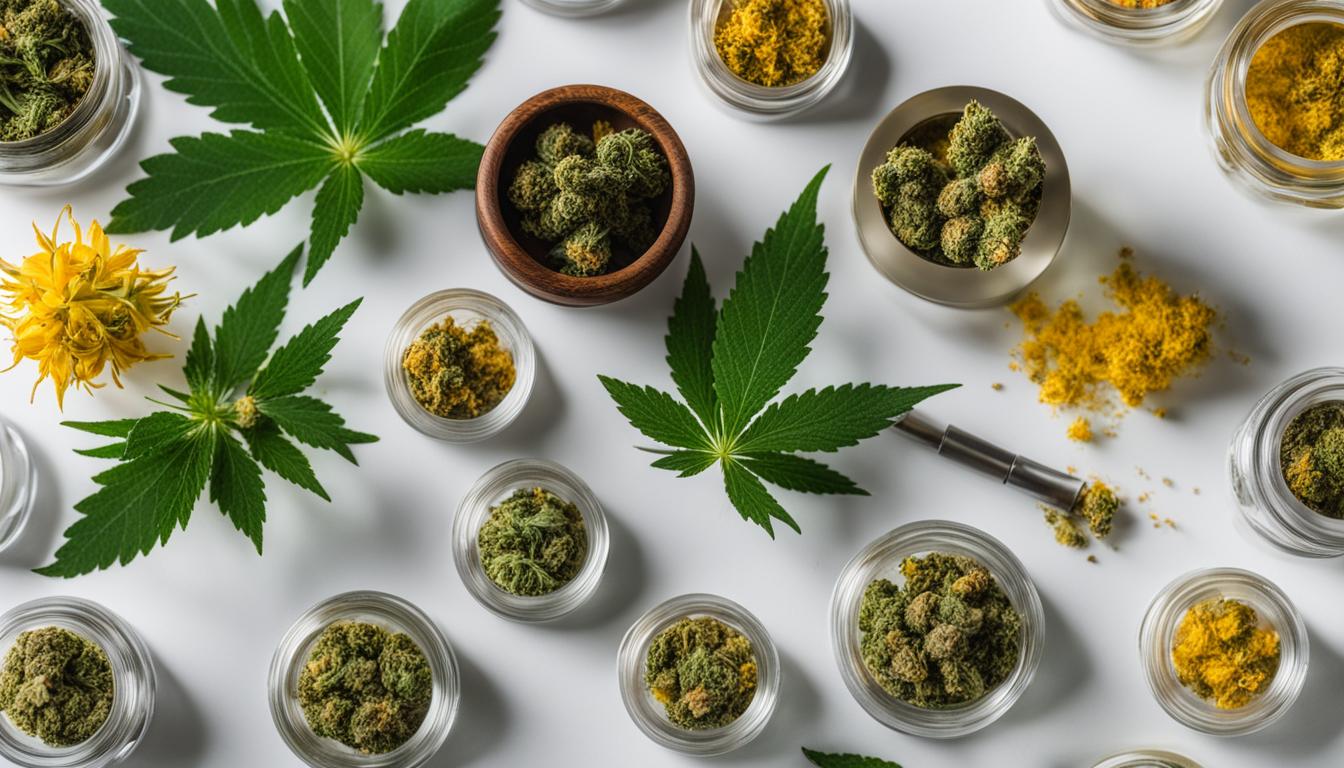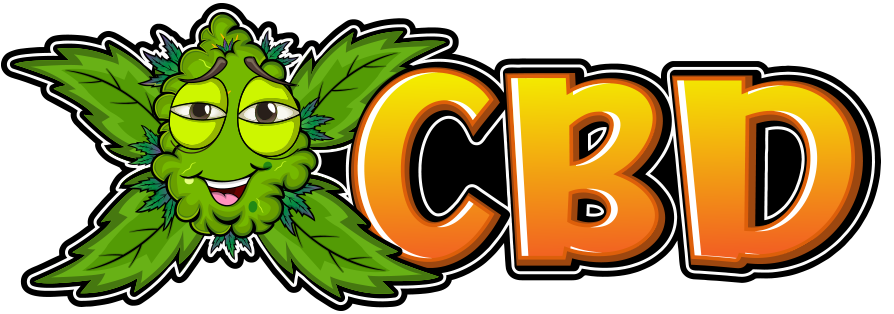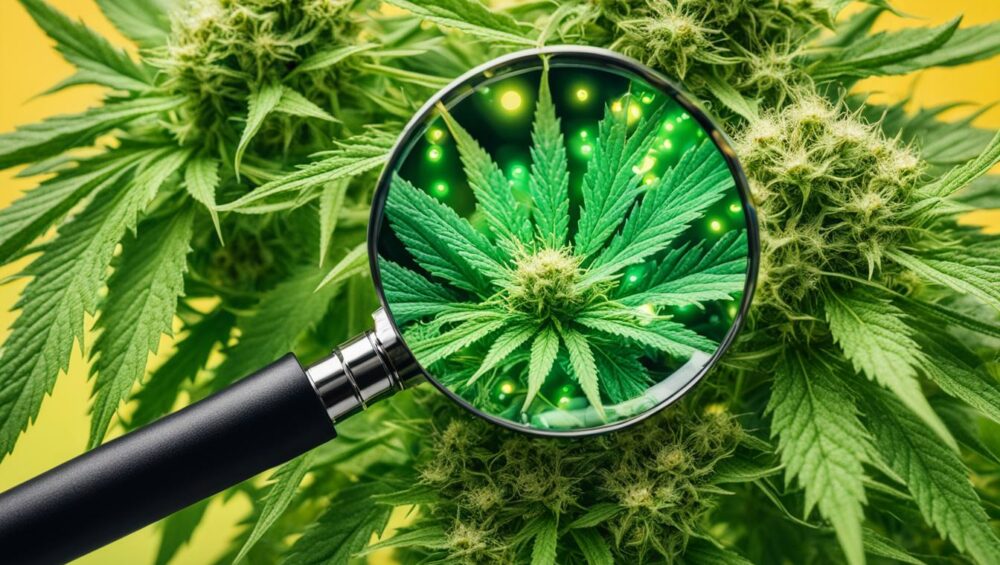Welcome to our comprehensive guide on understanding CBD potency and calculating CBD content in hemp flower. Whether you’re an enthusiast looking to maximize the benefits of your buds or a grower aiming to enhance your yields, accurate knowledge of CBD levels is crucial.
In this article, we will explore the importance of cannabis testing and how it can help you determine the CBD potency in your hemp flowers. By understanding the science behind CBD testing and exploring different methods, you’ll be equipped with the tools to make informed decisions about your CBD consumption or growing endeavors.
To begin, let’s delve into why calculating CBD content is essential for anyone seeking to harness the full potential of hemp flower.
Whether you’re an enthusiast looking to maximize the benefits of your buds or a grower aiming to enhance your yields, accurate knowledge of CBD levels is crucial.
Why Test THC Levels in Weed?
Testing THC levels in weed is essential for multiple reasons. Whether you’re a recreational user or prefer a holistic approach, understanding the cannabinoid concentration in your cannabis is crucial for gauging the effects and potency of the plant.
Recreational users rely on THC testing to anticipate the specific experiences they will have with different strains. While seed banks provide THC values, these figures are not always accurate due to the influence of genetics and environmental factors. By testing THC levels, users can gain a more precise understanding of the effects they can expect.
“Testing THC levels provides recreational users with valuable insights into the specific experiences they can expect from different cannabis strains.”
For holistic users, testing THC levels is a way to ensure they are fully aware of the exact blend of phytochemicals entering their bodies. By understanding the cannabinoid concentration, individuals can tailor their consumption to achieve the desired effects and make informed decisions about their cannabis use.
“Holistic users test THC levels to ensure they have a comprehensive understanding of the phytochemical blend they are consuming.”
Additionally, THC testing plays a significant role in dosing accuracy. By knowing the THC content in their weed, users can determine the appropriate dosage to achieve their desired effects while minimizing any potential adverse reactions.
Furthermore, THC testing provides invaluable insights for growers. By testing and analyzing THC levels, cultivators can experiment and refine their techniques to enhance the potency of their yields, allowing them to produce high-quality cannabis with consistent effects.
By testing THC levels in weed, both users and cultivators can gain a deeper understanding of the effects, potency, and overall quality of the cannabis they consume or grow.
Understanding the Science of THC Testing
In the world of cannabis testing, there are two primary methods to determine the THC content. The first involves relying on approximate figures provided by retailers, which are derived from lab testing. These figures offer a general idea of THC potency but may not be completely accurate.
THCA and THC are two distinct forms of the cannabinoid. THCA, or tetrahydrocannabinolic acid, is the raw and non-psychoactive form found in cannabis plants. It converts to THC, or tetrahydrocannabinol, through a process known as decarboxylation. Decarboxylation occurs when the plant material is exposed to heat, such as through smoking or vaporization.
Lab-tested products generally display the maximum THC content after decarboxylation. The conversion rate and molecular mass difference between THCA and THC are considered when calculating the actual THC value.
The Chemistry of THC Conversion
Decarboxylation is a crucial step in unlocking the full potential of THC. Without decarboxylation, cannabis flowers primarily contain THCA, which does not deliver the psychoactive effects associated with THC. Once heat is applied, the carboxylic acid group is removed from THCA, resulting in the creation of THC.
During the decarboxylation process, the molecular mass of THCA changes. It loses a carbon dioxide molecule (CO2), reducing its overall mass. This conversion rate is important for accurately determining the THC content in cannabis products.
| THCA Content | THC Content (After Decarboxylation) |
|---|---|
| 20% | 17% |
| 15% | 12.75% |
| 10% | 8.5% |
The THC content of a cannabis product is often represented as a percentage or milligrams per gram (mg/g). However, it’s important to note that these values are based on laboratory testing and consider the conversion rate from THCA to THC.
Understanding the science of THC testing is crucial for consumers and producers alike. Accurate testing provides valuable information about the potency and effects of cannabis products, enabling individuals to make informed decisions based on their desired THC experience.
What Types of Weed Can You Test?
When it comes to cannabis testing, there’s a wide range of weed varieties that you can analyze for their THC content. These include:
- Various strains of flower: Different strains of cannabis flower can have varying levels of THC. The potency of the flower depends on the specific strain and the conditions in which it was grown. Testing the THC content in different strains helps you understand the effects and choose the right product for your needs.
- Concentrates and extracts: Concentrates and extracts are cannabis products that have been processed to increase their potency. These products are made by extracting THC and other cannabinoids from the plant material. Concentrates and extracts typically have higher THC levels compared to flower, making them popular among experienced users seeking more intense effects.
- Oils: Cannabis oils, also known as tinctures, are liquid extracts of cannabis. These oils can be consumed orally or sublingually. Testing the THC content in oils helps you determine the potency and dosage of the product, allowing for accurate and controlled consumption.
- Edibles: Cannabis-infused edibles are food and drink products that are infused with THC. These products may list the total THC content in milligrams per serving, enabling you to regulate your consumption and experience the desired effects. Edibles offer an alternative way to consume cannabis, providing a longer-lasting and more potent experience compared to smoking or vaping.
Furthermore, there are other cannabis products like drinks and topicals that may require a different method of testing to measure their THC content accurately.
Testing different types of weed allows consumers and cultivators to make informed decisions based on the desired effects, potency, and personal preferences. Whether you prefer the traditional flower or want to experiment with extracts or edibles, cannabis testing provides valuable insights into the THC content of various products.

How to Test THC and CBD Levels in Weed
To ensure accurate knowledge of the THC and CBD levels in your cannabis products, there are three main testing methods available. Each method offers its own benefits and price points, allowing you to choose the one that best suits your needs.
Home Testing Kits:
For a simple and affordable option, home testing kits like color chart test kits are readily available. These kits typically include everything you need to conduct the test at home, including the necessary chemicals and a color chart for interpreting the results. While they may provide a general estimation of THC and CBD levels, they may not be as precise as other testing methods.
Thin-Layer Chromatography (TLC) Test Kits:
Alternatively, Thin-Layer Chromatography (TLC) test kits offer a more accurate way to test THC and CBD levels in your cannabis products. These kits utilize advanced chromatography techniques to separate and analyze various compounds, including minor cannabinoids. TLC test kits are more expensive than home testing kits but provide a higher level of precision.
Testing Gadgets:
For those seeking premium options, testing gadgets are available that connect to smartphones and provide detailed readings. These gadgets utilize advanced technology to accurately measure THC and CBD levels. While they offer precise results, they come at a higher price point.
Ultimately, the testing method you choose will depend on your budget, level of accuracy required, and personal preferences. Whether you opt for a home testing kit, a TLC test kit, or a testing gadget, each method will empower you with valuable information about the THC and CBD content of your cannabis products.
“Testing your cannabis products allows you to make informed decisions, ensuring you have the desired THC and CBD levels for a tailored experience.”
| Testing Method | Benefits | Price Range |
|---|---|---|
| Home Testing Kits | Simple and affordable | Low |
| Thin-Layer Chromatography (TLC) Test Kits | More accurate results, including minor cannabinoids | Medium |
| Testing Gadgets | Premium options, connect to smartphones for detailed readings | High |
The Importance of Reading the Label
When determining the THC content in CBD products, it’s crucial to pay close attention to the product label and look for the Certificate of Analysis (COA). The COA is a document provided by third-party labs that verifies the THC content and provides a comprehensive profile of cannabinoids present in the product. By relying on the COA and carefully reading the label, consumers can make informed decisions and ensure they are getting the desired THC content.
The product label may also list the THC content, but it’s essential to cross-reference it with the COA for accurate information. This extra step allows consumers to validate the THC content provided on the label and ensure it aligns with the verified laboratory results. By using both sources of information, consumers can have confidence in the THC content of the CBD product they are considering.
Here is an example of what a Certificate of Analysis (COA) might look like:
Reading the label and verifying the THC content through the COA is particularly important due to legal regulations surrounding THC levels in CBD products. Depending on the jurisdiction, there may be restrictions on the maximum allowable THC content in CBD products. By checking the label and COA, consumers can ensure they are staying within legal limits and avoid any potential legal implications.
Remember, the Certificate of Analysis (COA) and the product label are your best resources for determining the THC content in CBD products. Take the time to read and cross-reference these sources to make informed decisions about the THC levels in the products you consume.
How to Check THC Content in Different Types of CBD Products
When it comes to CBD products, it’s important to be aware of the THC content to ensure legal compliance, controlled consumption, and informed decision-making. Checking the THC content in different types of CBD products can be done by referring to the Certificate of Analysis (COA) and the product label.
Tinctures: To determine the THC content in tinctures, the COA provides precise details regarding the cannabinoid profile. Additionally, the label may indicate the THC content per droplet or milliliter, allowing for accurate dosing.
Edibles: When it comes to edibles, the THC content is usually specified on the packaging. This information is crucial as it enables users to consume the product within their desired THC limits, ensuring a controlled and enjoyable experience.
Oils: Similar to tinctures, oils may also list the THC content on the product label. This allows individuals to know the THC concentration and make informed decisions based on their preferences and needs.
Flower: In the case of CBD flower products, the THC percentage is often displayed on the packaging. This information is valuable for those who prefer smoking or vaping CBD flower, as it provides insights into the potency and effects of the product.
DIY Testing Kits: For a general estimation of THC content in CBD products, DIY testing kits are available. While these kits may not provide the same level of accuracy as professional testing, they can still offer valuable insights for individuals who want to have a rough idea of the THC levels in their products.
Understanding the THC content in different types of CBD products is crucial for a variety of reasons. It ensures legal compliance, allows for controlled consumption, and empowers individuals to make informed decisions based on their preferences and needs. By referring to the COA and the product label, users can be confident in the THC content of their CBD products.
Conclusion
Understanding the THC content in CBD products is paramount for legal compliance, personal preferences, and ensuring a positive experience. By carefully reading the product label and referring to the Certificate of Analysis (COA), individuals can access vital information about the THC content of CBD products.
Knowledge of THC levels empowers consumers to make informed decisions regarding their CBD consumption or purchases. Whether someone prefers products with low THC content to avoid any psychoactive effects or seeks higher THC levels for specific therapeutic benefits, having accurate information is crucial.
Additionally, being aware of the THC content in CBD products is essential for those who may undergo drug testing. By choosing CBD products with THC levels below the legal limit, individuals can mitigate concerns about potential positive drug test results.
To ensure safety and efficacy, it is recommended that individuals always read the label and cross-reference the THC content with the COA. Staying informed and opting for CBD products with accurate THC content information is the key to an optimal CBD experience.
FAQ
How can I calculate the CBD content in hemp flower?
To calculate the CBD content in hemp flower, you need to conduct cannabis testing. This testing allows you to determine the levels of THC, CBD, and terpenes in your buds. By knowing the CBD potency, you can better understand the effects and potency of your hemp flowers.
Why is it important to test THC levels in weed?
Testing THC levels in weed is important for a variety of reasons. For recreational users, it helps them gauge the effects they will experience. For holistic users, testing THC levels ensures they are aware of the exact blend of phytochemicals entering their bodies. Testing also helps with dosing accuracy and allows growers to experiment and improve the potency of their yields.
How does THC testing work?
There are two primary ways to test THC content. The first is by relying on the approximate figures provided by retailers based on lab testing. The second method involves using THC testing gadgets that connect to smartphones and provide detailed readings. Both methods have their own benefits and price points.
What types of weed can be tested?
You can test various types of weed, including different strains of flower, concentrates, extracts, oils, and edibles. However, the THC content can vary depending on the strain and growing conditions for flower. Concentrates and extracts tend to have higher THC levels compared to flower. Edibles may list the total THC content in milligrams per serving, and other cannabis products like drinks and topicals may require a different method of testing.
How can I test THC and CBD levels in weed?
There are three main ways to test THC and CBD levels in your cannabis products. Home testing kits like color chart test kits offer a simple and affordable option. Thin-Layer Chromatography (TLC) test kits are more expensive but provide more accurate results, including minor cannabinoids. Testing gadgets are premium options that connect to smartphones and provide detailed readings.
How can I check THC content in different types of CBD products?
When determining the THC content in CBD products, it’s important to read the label and look for the Certificate of Analysis (COA). The COA is a document provided by third-party labs that confirms the THC content and provides a full cannabinoid profile. The product label may also list the THC content, but it’s essential to cross-reference it with the COA for accurate information. Different types of CBD products may have specific information listed on the packaging, such as tinctures specifying THC content per droplet or milliliter, oils mentioning THC content on the label, and flower products displaying the THC percentage on the packaging.
Why is it important to read the label for CBD products?
Reading the label is crucial for understanding the THC content in CBD products. The Certificate of Analysis (COA) and product label provide information about THC content. By understanding the THC levels, individuals can make informed decisions about their CBD consumption or purchases, ensuring legal compliance, personal preferences, and avoiding unwanted effects.







